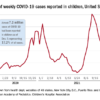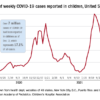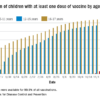A year into the COVID-19 pandemic, it is fair to say that children do transmit the virus, but at lower rates, Philip Zachariah, MD, of Columbia University, New York, said in a presentation at SHM Converge, the annual conference of the Society of Hospital Medicine.
Supportive care remains a key element in treating children with COVID-19, Dr. Zachariah emphasized. His presentation on pediatric hot topics in COVID-19 addressed several issues including the importance of risk stratification, current therapeutic options, and the latest on multisystem inflammatory syndrome in children (MIS-C) associated with COVID-19.
Recognize the high-risk patient
When it comes to identifying risk factors for COVID-19 in children, remember that the trajectory of disease is diverse, Dr. Zachariah said.
The presentations of COVID-19 in children include those who are older and/or have comorbidities and present with mainly respiratory issues, those who are younger with symptoms that might overlap with Kawasaki disease, and those who are older with symptoms of cardiac involvement and MIS-C.
The overall hospitalization rate for children with COVID-19 is approximately 5%, but once hospitalized, the rates of ICU admission are approximately 30% and reflect rates seen in adult patients, Dr. Zachariah noted.
In general, data show that underlying conditions are more common in acute COVID-19 cases, and laboratory anomalies are more pronounced in patients with MIS-C, he said.
Based on the most recent studies, independent risk factors for acute COVID-19 in children include extremes of age (infancy or adolescence), minority populations, obesity, medical complexity, immune compromise, and asthma.
However, data are limited on specific issues of medical complexity, and risk depends on the level and type of immunosuppression, as morbidity and mortality have been relatively low in transplant patients, Dr. Zachariah noted.
Another dilemma lies in recognizing MIS-C in a febrile child, Dr. Zachariah noted. A complex question, “but persistent high fever in the setting of known recent COVID-19 infections (within 3 to 6 weeks) seems key,” he said. “If given the chance to do one blood test, I would suggest doing a CRP [C-reactive protein] as a screening test,” Dr. Zachariah said. The best laboratory prognosticators appear to be lymphopenia and brain natriuretic peptide (BNP) he added.
A final risk factor is innate immune defects that might predispose previously healthy children to severe acute COVID-19, such as differences in cytokine expression, said Dr. Zachariah.
“For example, autoantibodies against type 1 interferon production may dispose to severe disease,” he noted. Patients with MIS-C have shown patterns of T-cell activation similar to those seen in severely ill adults, and activation of vascular patrolling CX3CR1+ CD8 + T cells appears as a distinguishing feature in MIS-C, he explained.
Prevention plans with monoclonal antibodies
Another hot topic in pediatric COVID-19 is the prevention of severe disease and hospitalization using the currently available therapies, Dr. Zachariah said. However, when interpreting efficacy data, clinicians are almost always extrapolating relative risk to absolute risk in children, he noted.
“Convalescent plasma was promising, but the data on efficacy are increasingly negative,” he noted. Instead, a more exciting development is the use of monoclonal antibodies, which, ideally, “will deliver protection to ‘high risk’ populations in the very early stages of infection,” he said.
Bamlanivimab/etesevimab is “a neutralizing IgG1 monoclonal antibody that binds to overlapping domains of the receptor binding domain of the spike protein of SARS-CoV-2,” said Dr. Zachariah. In a study of 1,035 patients with a median age of 56 years, a single intravenous infusion of bamlanivimab plus etesevimab within 3 days of a positive COVID-19 test showed a 70% reduction in risk of COVID-19 hospitalizations or death.
For children, the current Food and Drug Administration Emergency Use Authorization for monoclonal antibody use covers patients aged 12-17 years, who weigh 40 kg or more, and meet any of several other criteria: a body mass index at the 85th percentile or higher, sickle cell disease, congenital or acquired heart disease, neurodevelopmental disorders such as cerebral palsy, chronic respiratory disease requiring daily control, diabetes, or chronic kidney disease, Dr. Zachariah said.
In addition, pediatric patients aged 12-17 years could be considered for monoclonal antibody treatment in consultation with a pediatric infectious disease specialist if they are symptomatic with COVID-19, weigh at least 40 kg, are not hospitalized for COVID-19 symptoms, and have no new oxygen requirements, he said.
More on MIS-C
Currently, IVIG is the most common treatment for MIS-C in the United States, Dr. Zachariah said. In addition, a study published in JAMA Feb. 1, 2021, showed that IVIG in combination with methylprednisolone was associated with a lower risk of treatment failure compared to IVIG alone in 111 children with a median age of 8.6 years.
Although comparative effectiveness data are lacking, in long-term follow-up, all the patients seemed to be doing fine, Dr. Zachariah said. Potential second-line therapies for atypical MIS-C include anakinra and tocilizumab, he added.
Dr. Zachariah concluded by emphasizing the potential of COVID-19 vaccines, with studies underway for both Moderna and Pfizer vaccines in children younger than 16 years.
Dr. Zachariah had no relevant financial conflicts to disclose.
© Frontline Medical Communications 2018-2021. Reprinted with permission, all rights reserved.



